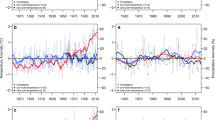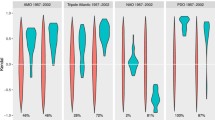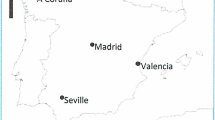Abstract
Night-time minimum temperatures are increasing, faster than day-time maximum temperatures. They are also strongly connected to key outcomes such as health, vegetation, and crop productivity, and therefore changes in the distributions of night-time minimum temperatures have strong impacts on living systems. Night-time minimum temperatures are also related to teleconnections, which are indices that capture climate phenomenon occurring on a large spatial and temporal scale. As autocorrelated sequences, teleconnections are predictable and therefore inform distributions of weather in the near future. In this paper, we link four well-known teleconnections to night-time minimum temperatures in the American Southwest. These teleconnections are covariates for the mean process, but also for the variance, which is modelled as an exponential generalized autoregressive conditional heteroskedastic process (AR-EGARCH). The resulting models are used to estimate the probability of a low temperature event across the phases of each teleconnection, demonstrating the impact each teleconnection has on variability of night-time minimum temperatures.





Similar content being viewed by others
References
Basrak B, Davis RA, Mikosch T (2002) Regular variation of GARCH processes. Stochast Process Appl 99(1):95–115
Benth JS, Benth FE (2012) A critical view on temperature modelling for application in weather derivatives markets. Energy Econ 34(2):592–602
Campbell SD, Diebold FX (2005) Weather forecasting for weather derivatives. J Am Statist Assoc 100(469):6–16
Dupuis DJ (2012) Modeling waves of extreme temperature: the changing tails of four cities. J Am Statist Assoc 107(497):24–39
Dupuis DJ (2014) A model for nighttime minimum temperatures. J Clim 27(19):7207–7229
Erhardt R, Engler D (2018) An extension of spatial dependence models for estimating short-term temperature portfolio risk. North Am Actuar J 22(3):473–90
Ghalanos A (2017) Introduction to the rugarch package.(Version 1.3-8). Manuscript, http://cran.r-project.org/web/packages/rugarch. Accessed 11 June 2020
Leathers DJ, Yarnal B, Palecki MA (1991) The Pacific North American teleconnection pattern and United States climate. Part I: regional temperature and precipitation associations. J Clim 4(5):517–528
Murage P, Hajat S, Kovats RS (2017) Effect of night-time temperatures on cause and age-specific mortality in London. Environ Epidemiol 1(2):e005
Nelson DB (1991) Conditional heteroskedasticity in asset returns: a new approach. Econometrica J Econ Soc 59(2):347–370
Newey WK, McFadden D (1994) Large sample estimation and hypothesis testing. Handbook Econ 4:2111–2245
Newman M, Alexander MA, Ault TR, Cobb KM, Deser C, Di Lorenzo E, Schneider N (2016) The Pacific decadal oscillation, revisited. J Clim 29(12):4399–4427
Pachauri R K, Allen M R, Barros V R, Broome J, Cramer W, Christ R, ... Dubash N K (2014) Climate change 2014: synthesis report. Contribution of Working Groups I, II and III to the fifth assessment report of the Intergovernmental Panel on Climate Change (p. 151). IPCC
Papalexiou SM (2018) Unified theory for stochastic modelling of hydroclimatic processes: preserving marginal distributions, correlation structures, and intermittency. Adv water Res 115:234–252
Pappas C, Papalexiou SM, Koutsoyiannis D (2014) A quick gap filling of missing hydrometeorological data. J Geophys Res Atmos 119(15):9290–9300
Peng S, Huang J, Sheehy JE, Laza RC, Visperas RM, Zhong X, Cassman KG (2004) Rice yields decline with higher night temperature from global warming. Proc Nat Acad Sci 101(27):9971–9975
Ropelewski CF, Halpert MS (1986) North American precipitation and temperature patterns associated with the El Niño/Southern oscillation (ENSO). Monthly Weather Rev 114(12):2352–2362
Rowe CM, Derry LE (2012) Trends in record-breaking temperatures for the conterminous United States. Geophys Res Lett 39(16):L16703
Shiflett SA, Liang LL, Crum SM, Feyisa GL, Wang J, Jenerette GD (2017) Variation in the urban vegetation, surface temperature, air temperature nexus. Sci Total Environ 579:495–505
Thompson DW, Wallace JM (1998) The Arctic Oscillation signature in the wintertime geopotential height and temperature fields. Geophys Res Lett 25(9):1297–1300
Turnbull MH, Murthy R, Griffin KL (2002) The relative impacts of daytime and night-time warming on photosynthetic capacity, Populus deltoides. Plant Cell Environ 25(12):1729–1737
Vose RS, Easterling DR, Gleason B (2005) Maximum and minimum temperature trends for the globe: an update through 2004. Geophys Res Lett 32(23):L23822
Author information
Authors and Affiliations
Corresponding author
Additional information
Publisher's Note
Springer Nature remains neutral with regard to jurisdictional claims in published maps and institutional affiliations.
Rights and permissions
About this article
Cite this article
Erhardt, R.J., Wang, Y. Influence of teleconnections on night-time minimum temperature variability in the Southwestern U.S.. Stoch Environ Res Risk Assess 35, 909–922 (2021). https://doi.org/10.1007/s00477-020-01894-x
Accepted:
Published:
Issue Date:
DOI: https://doi.org/10.1007/s00477-020-01894-x




